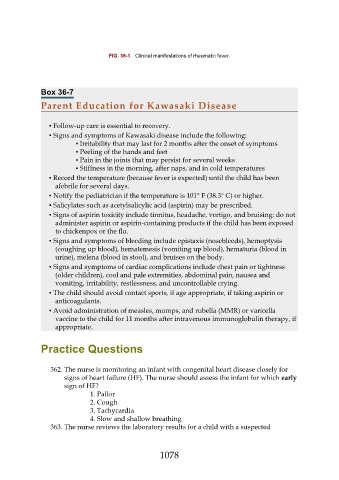Page 1078 - Saunders Comprehensive Review For NCLEX-RN
P. 1078
FIG. 36-1 Clinical manifestations of rheumatic fever.
Box 36-7
Parent Education for Kawasaki Disease
▪ Follow-up care is essential to recovery.
▪ Signs and symptoms of Kawasaki disease include the following:
▪ Irritability that may last for 2 months after the onset of symptoms
▪ Peeling of the hands and feet
▪ Pain in the joints that may persist for several weeks
▪ Stiffness in the morning, after naps, and in cold temperatures
▪ Record the temperature (because fever is expected) until the child has been
afebrile for several days.
▪ Notify the pediatrician if the temperature is 101° F (38.3° C) or higher.
▪ Salicylates such as acetylsalicylic acid (aspirin) may be prescribed.
▪ Signs of aspirin toxicity include tinnitus, headache, vertigo, and bruising; do not
administer aspirin or aspirin-containing products if the child has been exposed
to chickenpox or the flu.
▪ Signs and symptoms of bleeding include epistaxis (nosebleeds), hemoptysis
(coughing up blood), hematemesis (vomiting up blood), hematuria (blood in
urine), melena (blood in stool), and bruises on the body.
▪ Signs and symptoms of cardiac complications include chest pain or tightness
(older children), cool and pale extremities, abdominal pain, nausea and
vomiting, irritability, restlessness, and uncontrollable crying.
▪ The child should avoid contact sports, if age appropriate, if taking aspirin or
anticoagulants.
▪ Avoid administration of measles, mumps, and rubella (MMR) or varicella
vaccine to the child for 11 months after intravenous immunoglobulin therapy, if
appropriate.
Practice Questions
362. The nurse is monitoring an infant with congenital heart disease closely for
signs of heart failure (HF). The nurse should assess the infant for which early
sign of HF?
1. Pallor
2. Cough
3. Tachycardia
4. Slow and shallow breathing
363. The nurse reviews the laboratory results for a child with a suspected
1078

